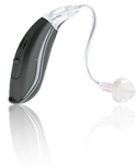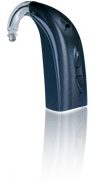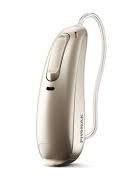Hearing Aids

How does a Hearing Aid work?
Hearing Aids consist of three main parts – a microphone, an amplifier and a speaker. The Hearing Aid operates by receiving sound through the microphone, converting these sound waves into electronic signals and sending them to the amplifier. The amplifier determines the power of the signal and sends these signals to the ear via the speaker.
What kind of Hearing Aids are available?
Almost all hearing aids are “digital” nowadays – most analogue aids have been superceded by this newer technology. Digital signal processing allows the hearing aid to perform functions that were not possible with analogue models, including rapid signal processing and wireless connections. Currently there are five styles of hearing aids available:

On the Ear (OTE)
hearing aids are a discrete and attractive fitting and are suitable for mild to moderate hearing loss. The sound is processed by the portion of the hearing aid sat behind the ear and then sent to the ear canal via a very fine hollow tube.

In the Ear (ITE)
are used for people with mild to severe hearing loss. As the name suggests, the aid fits completely inside the outer ear. The case is made up of a hard plastic case that holds the electronic parts. ITE hearing aids are usually not fitted in children as they need to be replaced each time the ear canal grows.

Behind the Ear (BTE)
hearing aids are used for people with mild to profound hearing loss. They consist of two sections. The outer section is made up of a plastic case that holds the electronics of the hearing aid. This is visible behind the ear. This case is connected to an earmould that is inserted into the ear, through which the sound travels. They are generally easier to operate and maintain as they are larger than other styles.

Canal aids
fit into the ear canal and are available in two styles. The in-the-canal (ITC) hearing aid is made to fit the size and shape of a person’s ear canal. A completely-in-canal (CIC) hearing aid is nearly hidden in the ear canal. Both types are used for mild to moderately severe hearing loss. They usually are not recommended for young children or for people with severe to profound hearing loss.

Receiver-In-The-Ear (RITE)
are the latest technology and have rechargeable options, in-built Bluetooth for smartphone and other connections, wireless options and can be fitted to most degrees of hearing loss. The aid utilises an on-ear processor connected to a tiny speaker that is positioned inside the ear canal.
